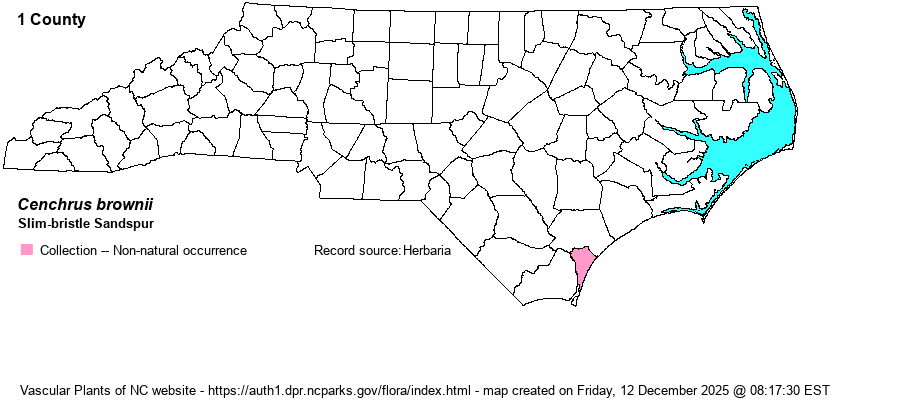| Author | Roemer & Schultes | |
| Distribution | A single specimen is known: "navalibus et vastis", August 1885, G. McCarthy s.n. (NCU). No county was given, and for convenience we fill in New Hanover, Wilmington being the most important NC port at that time. The specimen was annotated by M.T. Stieber in 1985.
Native to south Florida and the Neotropics; adventive in NC, GA, AL, TX. | |
| Abundance | Very rare and probably extirpated. A one-time waif. | |
| Habitat | Ship port waste area. | |
| Phenology | | |
| Identification | Slim-bristle Sandspur is similar to the native C. echinatus, but it differs in the proportions of bristles: in brownii most of the outer bristles are as long or longer than the flattened inner bristles (vs. half as long in the native species). | |
| Taxonomic Comments | Sandspurs are notorious for their extremely strong and sharp spines which catch on clothing, fur, and skin alike. The spines actually are flattened and extremely hardened bristles borne at the base of each spikelet. There also is a second set of bristles just outside the spines and not hardened. Care must be taken with a dissecting scope to reach accurate identification. NOTE: Some sites use "sandspur" and some use "sandbur" for the group common name for Cenchrus. In the Carolinas, at least, "sandspur" is much the more often used -- as do Weakley (2018) and RAB (1968) -- and thus the website editors are using that group common name. | |
| Other Common Name(s) | | |
| State Rank | SE? * | |
| Global Rank | G4G5 | |
| State Status | | |
| US Status | | |
| USACE-agcp | FACU link |
| USACE-emp | | |

